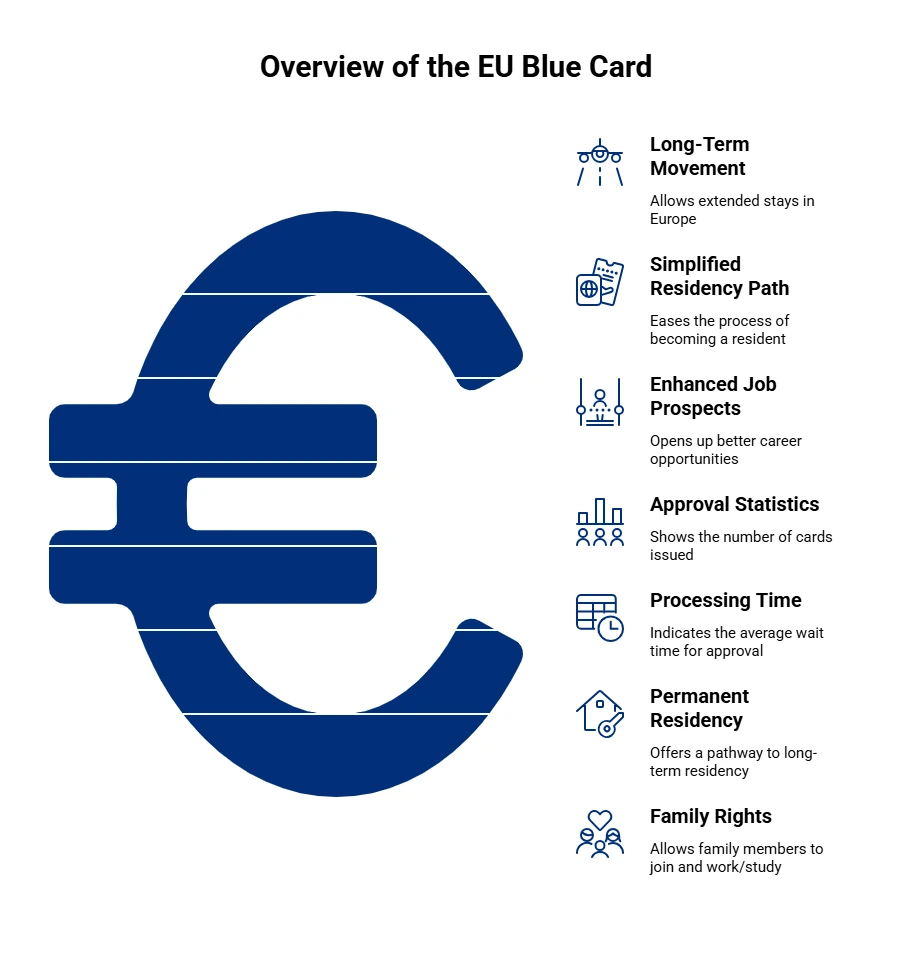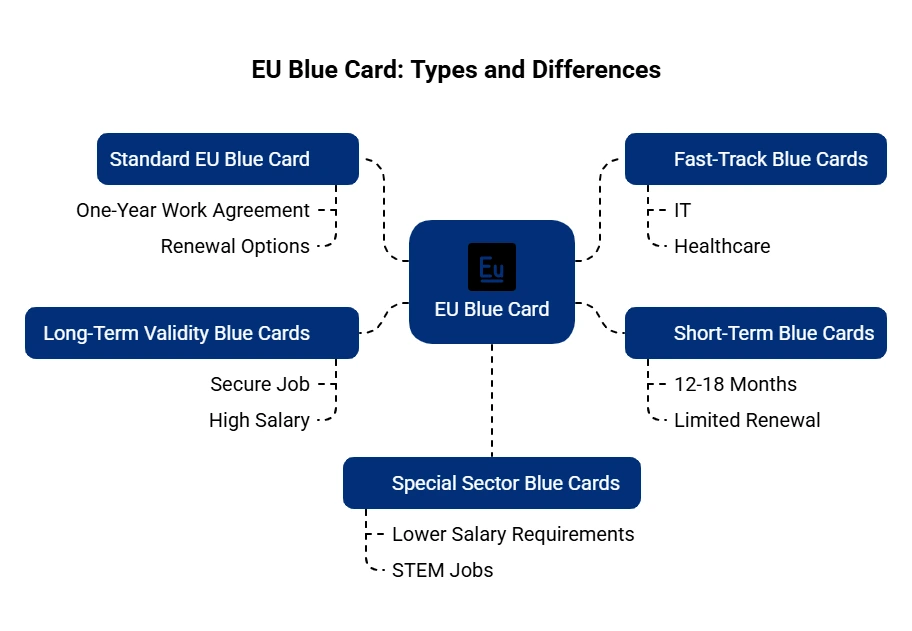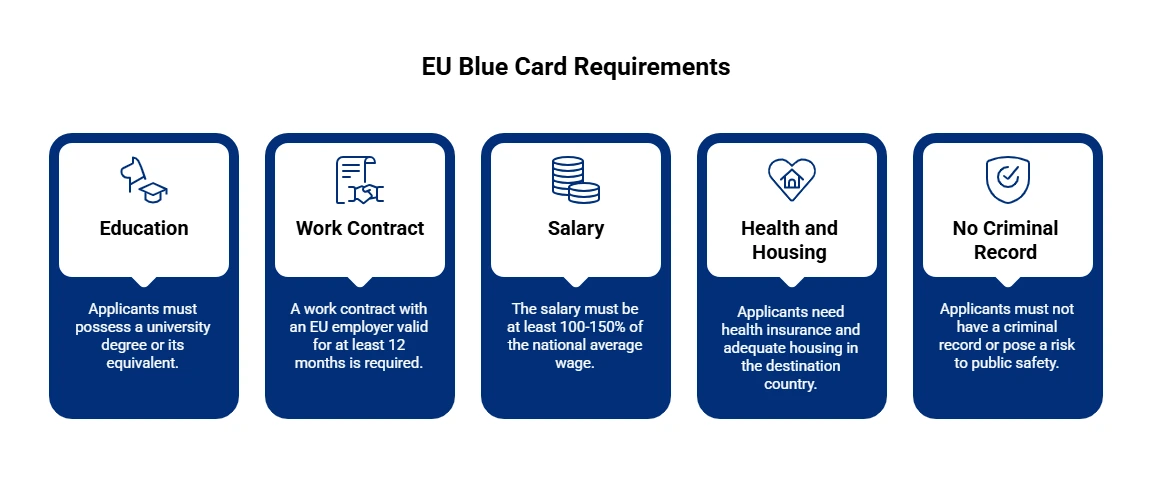EU Blue Card – A Complete Guide for UK Residents Seeking to Work in Europe
The EU Blue Card lets skilled workers from the UK work and live legally in many European nations. It offers long-term movement, a simpler path to residency, and better job prospects.
- Over 70,000 Blue Cards were given out across the EU in 2025.
- Germany is the leader, with almost 40% of all approvals.
- The average wait time in major countries is 4–8 weeks.
- Workers can apply for permanent residency in just 5 years.
- Family members can also join, with complete rights to work and study.

What is the EU Blue Card?
The EU Blue Card is a special work-and-residence permit for highly qualified, non‑EU nationals. It permits you to live and work in 25 of the 27 EU countries (excluding Ireland and Denmark), helping fill critical shortages in sectors such as IT, engineering, healthcare, and research.
*Looking for guidance to apply for work overseas? Let Y-Axis guide you with the process.
Why Choose the EU Blue Card Route?
The Blue Card provides several advantages, such as:
- It allows access to higher-paying jobs and career advancement in EU countries.
- It provides a route to permanent residency after approximately five years.
- Cardholders can bring their partners and children, who will have full rights.
- It simplifies changing EU countries after 12–18 months.
- It offers security and stability in countries with strong labor laws and public services.
Types of EU Blue Card Issued by Member States
The EU Blue Card has a standard structure, but each member state has its own rules about:
- Salary levels, which change from country to country (for example, Germany and France).
- How long the card is good for and how to extend it, usually from 1 to 4 years.
- Specific requirements for jobs like IT, healthcare, or STEM.
Even though the EU Blue Card has an EU framework, how it's put into action changes a bit from country to country. Each member state sets its own rules for things like salary and how long the card is good for, but the main needs are generally the same.
Here's a simple breakdown of common types and differences:
- Standard EU Blue Card: Usually requires at least a one-year work agreement. How long it lasts, from 1 to 4 years, depends on where you're applying. You can usually renew it if you keep your job.
- Fast-Track or Priority Blue Cards: Some countries speed up the process for important fields like IT, engineering, healthcare, and research.
- Short-Term Blue Cards: Sometimes, countries give out cards that last for 12 to 18 months for jobs that last for short term. These often cannot be renewed easily.
- Blue Cards with Long-Term Validity: If you have a secure, well-paid job, you might get a card that lasts several years, sometimes up to 4 or more, especially in places like Germany, France, and the Netherlands.
- Special Sector Blue Cards: To address local labor shortages, some countries set lower salary requirements or change the process for jobs that are in high need (like STEM, medical, or digital jobs).
Every EU country (except Ireland and Denmark) uses the Blue Card system within its own immigration setup. This means rules about salary, proof of housing, and how long it takes to bring your family over can be different.
If you are applying from the UK, be sure to check the specific rules of the country you want to move to.

Who Can Apply for an EU Blue Card from the UK?
Non-British citizens living in the UK with proper residency can apply if they meet these conditions:
- They have a firm job offer from an employer in the EU.
- The job requires a high skill level, usually a university degree.
- The job's salary is at or above the minimum set by the EU country.
British citizens cannot apply unless they also have citizenship in another eligible country.
*Want assistance to apply for migration overseas? Y-Axis is here to guide you with the process.
EU Blue Card Eligibility Criteria
To qualify for EU Blue Card, applicants must have the following:
| Criteria | Requirement |
| Higher Education | University degree or equivalent qualification |
| Job Offer | Employment contract in an EU country for at least 6 months |
| Salary Threshold | Minimum 1.5× host country average gross salary (varies by country) |
| Clean Record | No criminal convictions or security issues |
| Passport Validity | Must be valid for at least 6 months beyond intended stay |

Documents Required for an EU Blue Card Application
You must have the following documents while applying for the EU Blue Card:
| Document | Purpose |
| Valid Passport | Official identity and travel document |
| Employment Contract | Must meet salary threshold and duration conditions |
| Proof of Qualifications | Degrees or skill certificates |
| Health Insurance | Coverage in the EU country |
| Completed Application + Fee | Country-specific paperwork and payment receipt |
| Criminal Background Check | Required in some countries |
EU Blue Card Application Process (Step-by-Step)
The process to apply for EU Blue Card is given below:
Step 1: Get a valid job offer from an EU employer that meets the salary threshold.
Step 2: Ensure you meet the eligibility criteria (degree, passport, no criminal record).
Step 3: Collect all required documents, including contract, qualifications, and insurance.
Step 4: Submit your application to the immigration authority of the host country.
Step 5: Attend a biometric appointment or interview, if required.
Step 6: Wait for approval (usually 1–3 months depending on the country).
Step 7: Receive your EU Blue Card and travel to the host country.
Step 8: Register your address locally and begin employment.
.webp)
Country-Specific Application Portals
|
Country
|
Application Portal URL |
| Germany | [bluecard-eu.de] |
| France | [interieur.gouv.fr] |
| Netherlands | [ind.nl] |
| Austria | [migration.gv.at] |
| Sweden | [migrationsverket.se] |
Benefits of Holding an EU Blue Card
Here are some of the benefits you can get with an EU Blue Card:
- Legal right to live and work in the issuing EU country
- Family reunification fast-track for spouse and children
- Ability to move to another EU country after 18 months (conditions apply)
- Pathway to permanent residency in the host country
- Equal employment and tax treatment as EU nationals
EU Blue Card Costs and Fees
Detailed information about the costs and fees for an EU Blue Card is given below:
|
Cost Component |
Estimated Amount (EUR) |
|
Application Fee |
€100 – €140 |
|
Residence Permit Card Issuance |
€80 – €120 |
|
Biometric Registration |
Included or €10 – €30 |
|
Translations & Certification |
Varies |
|
Renewal Fee (if applicable) |
€80 – €120 |
EU Blue Card Processing Time
Detailed information about the processing time for EU Blue Card is given below:
|
Stage |
Estimated Timeframe |
|
Application Submission |
1 day |
|
Application Review |
4 – 12 weeks |
|
Biometric Appointment (if any) |
Within 1 – 2 weeks of request |
|
Decision Notification |
Included in review time |
|
Residence Card Issuance |
1 – 2 weeks after approval |
Validity, Renewal & Mobility within the EU
The validity, renewal, and mobility within the EU with the Blue Card is given below:
|
Category |
Details |
|
Initial Validity |
1 to 4 years (varies by country and employment contract duration) |
|
Renewal Eligibility |
Renewable if employment continues and all criteria are still met |
|
Renewal Frequency |
Typically aligned with new contract periods or national rules |
|
Mobility within EU |
Allowed after 12 months in the first EU country (or 6 months in some cases) |
|
Mobility Conditions |
Must apply for a new Blue Card in the second country before relocating |
|
Work Change Flexibility |
Can change employer after 12–24 months with notification to authorities |
|
Long-Term EU Residence |
Eligible after 5 years (including Blue Card periods in different countries) |
EU Blue Card vs Other European Work Visas
The primary differences between EU Blue Card and other European Work Visas are given below:
|
Feature |
EU Blue Card |
Other European Work Visas |
|
Purpose |
For highly skilled non-EU professionals |
General work or sector-specific employment |
|
Eligibility Criteria |
University degree + job offer + salary threshold |
Varies by country; may not require a degree |
|
Minimum Salary Requirement |
Yes (100%–150% of average national income) |
Varies; often lower or not specified |
|
Mobility Across EU |
Yes, after 12–18 months in the first country |
Usually limited to issuing country |
|
Family Reunification |
Fast-tracked with full work rights for dependents |
Available, but often slower or with limited rights |
|
Path to Permanent Residency |
After 5 years (including time spent in other EU countries) |
Varies by visa and country; often requires local continuity |
|
Processing Time |
4–12 weeks on average |
Varies widely; can be longer depending on the country |
|
Recognition Across EU |
Harmonised across most EU countries |
Country-specific rules and recognition |
|
Flexibility to Change Employer |
Allowed with notification after initial period |
Depends on national visa rules |
|
Aimed at |
Skilled professionals seeking EU-wide opportunities |
Workers with offers in specific sectors or lower-skill roles |
Permanent Residency & Citizenship through the EU Blue Card
After legally living in a country for 5 years with a Blue Card and having spent at least 2 years in the country where you are applying you can seek EU long-term resident status. Based on the country's regulations, you might qualify for citizenship sooner, mainly in countries that offer faster naturalization.
Bringing Your Family with the EU Blue Card
Your spouse or registered partner, along with your dependent children, is eligible to apply to join you. If their applications are approved, they will have the right to live, work, and study in the country. Please note that you may need to supply proof of adequate housing and means of support. In general, family reunification requests are processed together with the main application to make the transition easier.
Common Reasons for EU Blue Card Rejection
Applications could be denied when:
- The job offer or salary fails to meet the set national standards.
- Qualifications lack proper validation or recognition.
- Documents are missing, incomplete, or inaccurate.
- The employer's business registration is not valid.
- The applicant has immigration violations or criminal convictions.
How Can Y‑Axis Help You?
Y-Axis helps UK residents apply for the EU Blue Card in their desired country by:
- Assessing eligibility and giving salary insights.
- Helping prepare and validate documents.
- Helping schedule appointments for embassy or online submissions.
- Advising on family matters, housing, and local registration.
- Support the family reunification process
- Providing complete help from job offer to settling in and getting around.
Looking for Inspiration
Explore what Global Citizens have to say about Y-Axis in shaping their future
Frequently Asked Questions
